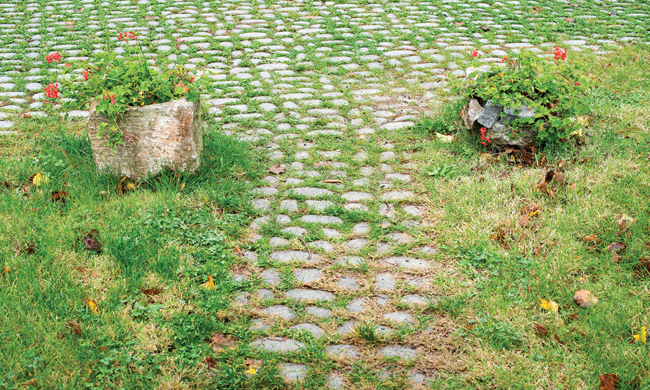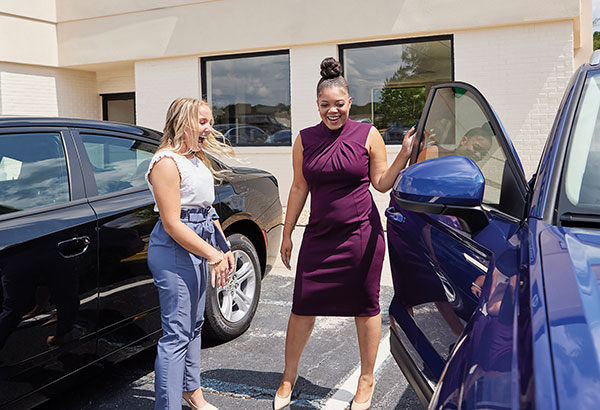Live Better
9 troublesome weed zones to tackle


(Family Features) Weeds are opportunists that take advantage of bleak growing conditions to set root. If you’ve ever seen a weed growing out of a crack in your driveway or other paving, you know that weeds, by nature, can adapt to almost any spot.
As you work to get your yard in shape, keep an eye on the following areas that often offer ideal conditions for weeds to grow and reproduce.
- Pathways. Paths made from loose materials, such as bark mulch, decomposed granite or stones, can act as seeding beds, offering a natural spot for weeds to grow.
- Underneath shrubs. Areas under shrubs can be hard to reach, shady and moist – a perfect place for weeds.
- Unpaved drives and parking areas. Whether grassy, muddy or filled with gravel, these areas often roll out the welcome mat for weeds.
- Cracks and crevices. Cracks between paving stones, bricks or slabs of concrete provide natural entry points for weeds. If the weeds are not dealt with, roots can lift pavers or bricks, creating dangerous uneven spots while potentially ruining the clean look of your patio or walkway.
- Beneath decks. Despite sparse sunlight, weeds may still grow under decks.
- Around downspouts. Weeds often thrive at the base of downspouts where moisture is abundant. Heavy rains can wash seeds from these weeds into other areas of your yard.
- Along fences and foundations. Often out-of-sight and out-of-mind, these areas are natural spots for weed build-up.
- Freshly tilled soil. Anytime you turn soil or an animal digs a hole, you expose buried weed seeds, creating an area to watch for new seedlings.
- Open soil. Keep a close watch on your yard for dead spots or open areas. Fill them in as soon as you can, adding new plants, seeds or mulch. Bare spots in lawns should be over-seeded with desirable grass seed. In new plantings, cultivate often to uproot new weed seedlings.
There are many ways to control weeds, including hand-pulling, hoeing, mulching or using herbicides. People often try homemade, natural weed killers like vinegar to avoid herbicides. However, these “natural” techniques often don’t kill the roots of the weeds, so they quickly regrow. Alternatively, consider an environmentally friendly option like Natria Grass & Weed Control With Root Kill. You’ll usually see results within minutes and weeds are not likely to come back from their roots, unlike when using natural solutions.
For more information on controlling weeds, visit natria.com.
Photo courtesy of Getty Images
SOURCE:
Natria
Live Better
Turn your tax refund into a new ride

Make a major purchase more manageable
(Family Features) With tax refunds starting to flow in, many people are considering ways to invest their money.
If you’re looking to purchase a vehicle, putting your tax refund toward a down payment on a used car can be a smart financial decision for several reasons – from reduced interest rates on your loan and shortened loan terms to lower monthly payments – and the timing is right to take advantage of improving market conditions. Consider this information to help make an informed buying decision.
Lower Your Monthly Payment
The more you can invest in the down payment of a vehicle, the lower your monthly cost will typically be and the less interest you will typically pay over the length of the loan. This can lead to smaller, more manageable monthly payments.
A significant down payment can also help offset higher-than-average interest payments and could lead to a shorter term, meaning less total accrued interest. An auto loan calculator can show you how a down payment can affect interest charges.
More Affordable Vehicle Options Used car prices have been trending downward month-over-month, according to the Bureau of Labor Statistics’ consumer price index. These decreases in used car prices are helping offset higher than normal interest rates. The average sales price for a pre-owned vehicle through Enterprise Car Sales, for example, is approximately $21,000 right now, compared to average new car prices, which are hovering around $44,000.
Used car prices have been trending downward month-over-month, according to the Bureau of Labor Statistics’ consumer price index. These decreases in used car prices are helping offset higher than normal interest rates. The average sales price for a pre-owned vehicle through Enterprise Car Sales, for example, is approximately $21,000 right now, compared to average new car prices, which are hovering around $44,000.
Vehicle inventory is improving along with an increase in consumer demand for cars, which makes now an attractive time to buy. Many used car sellers feature inventory that is readily available so you can select from options you know are in stock, including different makes and models with a wide range of different features that can offer more affordable options.
“We have a large inventory of vehicles across the country currently priced under $20,000,” said Mike Bystrom, vice president of Enterprise Car Sales. “There are several considerations to keep in mind when shopping for a vehicle, and there is no one-size-fits-all approach. Consumers should weigh their options, but the one thing they shouldn’t compromise on is receiving great customer service.”
Protect Your Purchase
Ensuring your purchase is protected is also a smart financial decision. Take advantage of dealers that offer additional benefits to help protect your purchase and provide peace of mind that your tax refund has been well spent.
Look for a used vehicle that has passed an inspection by an ASE-certified technician and comes with a limited powertrain warranty, as well as extra coverage options such as roadside assistance and a return policy up to a certain amount of days or mileage.
With a little research and careful planning, you can find a reliable used car that meets your needs and puts your tax refund to good use. Visit enterprisecarsales.com for more information.
SOURCE:
Enterprise Car Sales
Live Better
Get ready to grill: Choosing the right outdoor cooking solution

(Family Features) Warmer temperatures and sun-filled days mean it’s time to take entertaining and socializing outdoors, and a key component of many outdoor gatherings is fresh-grilled food.
Because firing up the grill can make prepping meals quick and easy, it allows you to spend more time with friends and family rather than missing out on the sunshine while stuck in the kitchen. Whether you’re a first-time griller or consider yourself a master of the grates, there’s a grill available to meet your skill level and needs, such as these options that provide flexibility for small-to-midsize backyard spaces – as well as a large built-in model for custom outdoor kitchens – and a variety of features and function to make the most of your warm weather gatherings.

Portable, Small-Space Cooking
Ideal for first-time grillers, couples, small families or those with limited backyard spaces, the Megamaster 3-Burner Gas Grillwas designed to fuse performance and value. Despite its size, it can cater to almost any grilling or entertaining need with three stainless steel burners and 447 square inches of cooking space, a combination of versatility and capacity to prepare large quantities of food as well as various types of food simultaneously. Plus, it’s easy to maneuver on two heavy-duty wheels, making it simple to free up patio space after use. Learn more at megamaster.com.

Family-Sized Functionality
With ample cooking space to feed small and medium-sized groups, the Nexgrill 4-Burner Gas Grill with Side Burner is a perfect all-around grill for both beginners and seasoned grilling enthusiasts. Always ready to fire up some flavor, the durable grill also features a stainless steel side burner to saute, simmer and warm dishes simultaneously as well as 628 square inches of cooking space, meaning family favorites like burgers, dogs, chicken and more can be put on the table quickly. Find more information at nexgrill.com.

Elevate Your Outdoor Kitchen
If your outdoor living area includes enough space, you can elevate the outdoor cooking experience with an outdoor kitchen. Put a premium, built-in grill like the Spire 6-Burner Built-In Grill at the center of your custom, luxurious entertaining space. This dual-fuel, stainless steel gas grill features 904 square inches of cooking space and 73,000 British thermal units of cooking power across six main burners and an intense-heat ceramic rear burner, producing restaurant-quality sear marks and exceptional heat retention. Visit spireoutdoor.com to learn more about the durable, high-performance grilling solution.
SOURCE:
Megamaster
Nexgrill
Spire
Live Better
Tips to make your AC more energy efficient, sustainable

(Family Features) Updating your HVAC (heating, ventilation and air conditioning) system to cool your home in a smart and sustainable way involves several steps that not only improve energy efficiency but also reduce environmental impact.
Consider these tips from the heating and cooling experts at Carrier to help make your cooling system more eco-friendly:
- Upgrade to an Energy-Efficient HVAC System. If your HVAC system is outdated, consider replacing it with a more energy-efficient model. Look for systems with an Energy Star or high SEER2 (seasonal energy efficiency ratio) rating, which indicates better energy efficiency. The higher the SEER2 rating, the more efficient the unit. Financial incentives for installing a higher-efficiency system are available through the Inflation Reduction Act of 2022. You can also shop for rebates from manufacturers and utility companies.
- Look for a Carbon-Free HVAC System. Heat pumps, ductless and VRF (variable refrigerant flow) systems that run on electricity and use low global-warming potential refrigerant, like Carrier’s Puron Advance, can help reduce your home’s negative impact on the environment.
- Install a Smart Thermostat. A smart thermostat can be programmed based on your preferences and adjust temperatures automatically. These devices can be controlled remotely through smartphones and help reduce energy consumption by cooling your home only when necessary.
- Conduct Regular Maintenance. Keep your HVAC system running efficiently with regular maintenance. This includes cleaning or replacing air filters every 1-3 months, checking refrigerant levels, cleaning outside condenser coils and ensuring the system’s components are in good, working condition and the airflow is not blocked.
- Seal and Insulate. Improve your home’s insulation to maintain a consistent temperature. Seal windows, doors and any gaps or cracks to prevent cool air from escaping. This can significantly reduce the workload on your HVAC system.
- Use Ceiling Fans. Ceiling fans can help circulate cool air throughout your home, allowing you to set the thermostat at a higher temperature without sacrificing comfort, thus saving energy.
- Add Window Treatments. Use blinds, shades or curtains to block out sunlight and reduce heat gain during the hottest parts of the day. This simple step can make a big difference in how much your air conditioner needs to work.
- Upgrade to a Variable-Speed Compressor. Traditional compressors operate at full power or not at all. However, a variable-speed compressor can adjust its output to match your cooling needs precisely, resulting in better efficiency, energy savings and improved indoor comfort.
- Ventilate Properly. Ensure proper ventilation in your home, especially in areas like the kitchen and bathroom, to remove excess heat and humidity, which can reduce the need for air conditioning.
- Update Roofing. If you’re replacing your roof, consider cool roofing materials that reflect more sunlight and absorb less heat than standard roofing materials, reducing the heat that enters your home.
By implementing these strategies, you can improve or update your HVAC system to cool your home more sustainably. Not only do these steps help the environment, they can also lead to lower energy bills and improved indoor comfort. Always consult with an HVAC professional to determine the best and most efficient options for your home and needs.
Find more information and tips to sustainably cool your home at Carrier.com.
SOURCE:
Carrier
-

 NEWS1 year ago
NEWS1 year ago2 hurt, 1 jailed after shooting incident north of Nocona
-

 NEWS6 months ago
NEWS6 months agoSuspect indicted, jailed in Tia Hutson murder
-

 NEWS1 year ago
NEWS1 year agoSO investigating possible murder/suicide
-

 NEWS1 year ago
NEWS1 year agoWreck takes the life of BHS teen, 16
-

 NEWS9 months ago
NEWS9 months agoMurder unsolved – 1 year later Tia Hutson’s family angry, frustrated with no arrest
-

 NEWS1 year ago
NEWS1 year agoSheriff’s office called out to infant’s death
-

 NEWS1 year ago
NEWS1 year agoBowie Police face three-hour standoff after possible domestic fight
-

 NEWS1 year ago
NEWS1 year agoDriver stopped by a man running into the street, robbed at knifepoint





